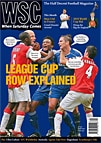 As well as being involved in violence, Italian fan groups have been about flags, flares and noise. Pete Green looks at attempts to improve the atmosphere at UK grounds by importing the best of ultra culture
As well as being involved in violence, Italian fan groups have been about flags, flares and noise. Pete Green looks at attempts to improve the atmosphere at UK grounds by importing the best of ultra culture
“It’s not about copying the nutters in Italy,” insisted one supporter as a Leicester message board recently heated up over the formation of a local ultras group. Those involved may be quick to dissociate themselves from the nastier extremes of their counterparts on the European mainland, but with Italian authority figures calling for a more English approach to crowd control after the recent death of police officer Filippo Raciti at the Catania v Palermo derby, it is difficult to miss the irony of UK fans seeking to co-opt a notorious aspect of Italian football culture.
Small but well established ultra groupings exist at a handful of British clubs; moves are afoot to form several more and there are other, similarly minded groups that don’t use the ultra name. But if the movement is, as the Ultras UK website states, “against politics or violence in football”, what is it for? It is a reaction against the corporate dulling-down of matchdays: against the big clubs’ prawn-sandwich faction; against snatches of music being piped down the stadium PA system to “celebrate” a goal for the home side; against the swathes of all-seated silent support, distant physically and emotionally.
Rejecting these aspects of football today becomes an all-encompassing denial of modernity in the Italian ultras’ motto “No al calcio moderno” (No to modern football). Rather than campaign for a return to two points for a win, though, ultras in the UK concern themselves mostly with making matchdays a visual and aural carnival, festooning the stands with flags, banners, cards and streamers (the choreographed tifo display), and making an almighty racket.
Andy Hunt is a Leicester fan involved in setting up an ultras-type group. “It’s like a library there,” he says of the Walkers. Members have already met club officials to designate a “singing section”, which made an immediate and noisy impact in the derby against Coventry. The group is yet to agree on a name and Andy remains mindful of negative connotations: “We decided not to jump into the ultras thing straight away, because of the problems in Italy. But people in England don’t realise what the ultra scene’s about. It’s nothing to do with the hooligans.”
“We’ve played down the name ‘ultra’ until recently,” agrees Mike Grafton of Crystal Palace’s Holmesdale Fanatics. The Fanatics came together in the late 1990s and have helped no end in perking up the atmosphere at Selhurst. “We were absolutely disenchanted at the matchday environment,” says Mike. “We organised a card display in 2000, which was pretty pioneering then. The club was in a state, we were in administration and it was a strong sign of positive support for the players. Since then we’ve definitely made an impact.”
The Holmesdale Fanatics are scathing of attempts by officials at clubs such as Chelsea and Reading to co-ordinate ultra-style tifo displays. “The chairmen look abroad and look at the displays put on by the ultras at Aberdeen and Accrington and try and buy into it,” Mike explains. “But it has to be from the bottom up.”
Standing is another big issue. Ultra groups are firmly behind the Stand Up Sit Down campaign for the reintroduction of open terracing in England’s top two divisions – and in the meantime they are standing up anyway in defiance of the rules.
Some might find inconsistencies in the ultras’ ideology – or professed lack of ideology. Any stance “against politics” is political in itself, of course, and Stand Up Sit Down have devoted much energy to lobbying MPs in a bid to change the law. Nor does their aversion to the commercialisation of the game restrain them from selling their own lines of merchandise. And while ultras strenuously distinguish themselves from hooligan groups, the boundaries quickly start to blur online. Ultras UK links to Ultras Spirit, an internet clothing store offering hoodies that bear the slogan “ALL COPS ARE BASTARDS” and including English-based hooligan sites alongside its links to the respectable tifosi of Accrington and York; while Swindon’s Red Army Loud & Proud site notes approvingly that their ultras’ use of flares during a 1990s derby against Oxford “earnt the respect of… Swindon’s top firm”.
None of this is a direct endorsement of violence, but the ultras will need to take care if they are to convince a wary public of their good intentions. At its best ultra culture is a vibrant expression of grassroots identity; an assertion of the game’s moral ownership in spectacular counterpoint to the ultimately meaningless paper shuffling of sponsorship deals and takeovers. For better or for worse, it demonstrates limits to the control that can be imposed on the game from above – and if the authorities are uncomfortable with that, then they might need to examine how, for two decades, they have sucked the life out of British football grounds.
From WSC 242 April 2007. What was happening this month